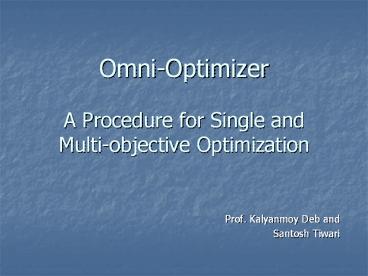Omni-Optimizer A Procedure for Single and Multi-objective Optimization - PowerPoint PPT Presentation
Title:
Omni-Optimizer A Procedure for Single and Multi-objective Optimization
Description:
Omni-Optimizer A Procedure for Single and Multi-objective Optimization Prof. Kalyanmoy Deb and Santosh Tiwari – PowerPoint PPT presentation
Number of Views:107
Avg rating:3.0/5.0
Title: Omni-Optimizer A Procedure for Single and Multi-objective Optimization
1
Omni-OptimizerA Procedure for Single and
Multi-objective Optimization
- Prof. Kalyanmoy Deb and
- Santosh Tiwari
2
Motivation
- Generic Programming Practices
- Unified algorithm for all types of optimization
problems - An efficient implementation of NSGA-II framework
(procedure) - Developing an efficient and self-adaptive
optimization paradigm
3
Literature Survey
- CHC (Cross generation elitist selection,
Heterogeneous recombination, Cataclysmic
mutation) Explicit Diversity - GENITOR (Steady state GA), more like (µ1)-ES so
far as selection mechanism is concerned. High
selection pressure - NPGA (Niched Pareto Genetic Algorithm), uses
sharing parameter sshare of niches obtained
depend on the sharing parameter
4
Literature Survey contd
- PESA (Pareto Envelope-based Selection Algorithm),
Hyper-grid division of phenotypic space,
selection based on crowding measure - NSGA-II (Non-dominated Sorting Genetic Algorithm)
- SPEA2 (Strength Pareto Evolutionary Algorithm),
Fine grained fitness assignment mechanism
utilizing density information, Only archive
members participate in mating Excellent
Diversity in phenotypic space - NCGA (Neighborhood Cultivation Genetic
Algorithm), used neighborhood crossover, based on
NSGA-II and SPEA2 - RPSGAe (Reduced Pareto Set Genetic Algorithm with
elitism) - ENORA (Evolutionary Algorithm of Non-dominated
Sorting with Radial Slots)
5
Salient Features of the Algorithm
- Based on NSGA-II framework
- Based on the concept of Pareto dominance
- Incorporates elitism
- Explicit diversity preserving mechanism
- Can be used for single-objective as well as
multi-objective problems - Can be used for uni-global as well as
multi-global problems - Independent of the number of niches that an
optimization problems exhibits
6
Moving beyond NSGA-II
- Restricted Selection Scheme
- Tournament selection based on usual domination
- Non-dominated sorting based on epsilon dominance
- Crowding Distance Assignment
- Genotypic as well as Phenotypic space niching
- Choose best members from above average population
- Remove worst members from below average
population - More robust recombination and variation operators
- Two point crossover for binary variables
- Highly disruptive real variable mutation
7
Restricted Selection
- Helps in preserving multi-modality
- Experiments show that it gives faster overall
convergence
8
Epsilon Domination Principle
- A finite percentage (based on function value) of
solutions assigned a particular rank - Allows somewhat inferior solutions to remain in
the population - Provides guaranteed diversity
- Helps to obtain multi-modal solutions in case of
single objective problems - Epsilon is generally taken in the range 10-3
10-6
9
Modified Crowding Distance
- Genotypic as well as Phenotypic space niching
10
Highly Disruptive Mutation Operator
11
Computational Complexity
- Restricted selection O (nN2)
- Ranking procedure O (MN2)
- Crowding procedure
- max O (MN log N), O (nN log N)
- Overall iteration-wise complexity
- max O (nN2), O (MN2), O (nN log N)
12
Implementation Details
- Code written in simple C and strictly conforms to
ANSI/ISO standard - Data structure used is a custom doubly linked
list (gives O(1) insertion and deletion) - Randomized quick sort used for sorting
- Almost all the functions perform in-place
operation (addresses are passed, significantly
decreases stack overheads)
13
Simulation Results
- GA parameters for all problems chosen as follows
- ?c 20
- ?m 20
- P (crossover) 0.8
- P (mutation) 1/n, where n of real variables
- d 0.001
- Population size and number of generations
different for different problems
14
Simulation Results contd
- 20 variable Rastrigin function
- of function evaluation
- Least 19260
- Median 24660
- Worst 29120
- 20 variable Schwefel function
- of function evaluation
- Least 54950
- Median 69650
- Worst 103350
- Other single objective problems can be found in
the paper - In all cases, better results are found in
comparison to previous reported studies
15
Single objective multi-modal function
- f(x) sin2 (px) x ? 0,20
16
Single objective multi-modal function
- Unconstrained Himmelblaus function
17
Multi-objective Uni-Global Test Problems
- 30 variable ZDT2 (100100)
18
Multi-objective Uni-Global Test Problems
- 10 variable ZDT4 (100250)
19
Multi-objective Uni-Global Test Problems
- CTP4 (1007000)
20
Multi-objective Uni-Global Test Problems
- CTP8 (100100)
21
Multi-objective Uni-Global Test Problems
- DTLZ4 (300100)
22
Multi-objective Multi-Global Test Problem
- F1 (x) summation (sin (pxi) ) xi ? 0,6
- F2 (x) summation (cos (pxi) ) xi ? 0,6
Efficient points in phenotypic space
23
Multi-objective Multi-Global Test Problem
- Genotypic space plots
24
Few Sample Simulations
- F(x) sin2 (10,000pix)
- Himmelblaus Functions
- ZDT Test Problems
- CTP Test Problems
- Test Problem TNK
- Multi-global Multi-objective Test Problem
25
Further Ideas and Future Work
- Incorporating PCX instead of SBX for crossover
- Automatically fine-tuning mutation index so as to
achieve arbitrary precision - Self-adaptation of parameter d
- Segregating population into niches without the
introduction of DM - Dynamic population sizing
- Using hierarchical NDS for the crowding distance
assignment
26
(No Transcript)































